Roma Children’s Language Learning and its Relation to “Theory of Mind”
Received: 08/08/2021
Accepted: 10/23/2021
DOI: 10.11621/ nicep.2021.0105
To cite this article:
Kyuchukov, H. (2021). Roma Children’s Language Learning and its Relation to “Theory of Mind”. New Ideas in Child and Educational Psychology, 1 (1), 96–118. DOI: 10.11621/ nicep.2021.0105
Background. IQ tests given to Roma children by J.P. Rushton and J. Cvorovic (2007) using non-verbal tests, and a new study by D. Dolean and A. Calugar (2020) have supported the conclusion that the Roma are less intelligent than white people. But even these nonverbal tests used the official language of the country for instructions. So, if the children did not understand the instructions, they obviously could not perform the tests correctly. There was no Romani translator available nor were the instructions given in the children’s mother tongue. Nor did those authors take into consideration the Nazis’ research done by pseudo-scientists during World War II, or know what the consequences of this kind of research could be. We argue that Roma children, being bilingual, have knowledge of different Romani grammatical categories, and that their knowledge of their mother tongue helps them to understand the Theory of Mind (ToM), which is another type of intelligence. The connection between language and solving Theory of Mind tasks is also an important aspect of the development of children’s intelligence.
Objective. This study addresses the following research questions: 1) At what age do Roma children know what kind of grammatical categories in their mother tongue (L1) and in their second language (L2)?; and 2) How is knowledge of these grammatical categories related to the understanding of ToM tasks? Our hypothesis was that if a child knows more about the complex grammatical categories in one of the two languages he speaks (L1 or L2 ), it will help him gain better understanding of the ToM in the other language.
Design. Thirty preschool Roma children from Croatia were divided into three age groups (3-4 years old; 4-5 years old; and 5-6 years old), with 10 children in each group. They were tested with two types of tests: a Romani language assessment test which measured the children’s level of knowledge of different grammatical categories in their mother tongue (Romani) and their second language (Croatian). The second type of tests involved the two classical False Belief tasks which measure the level of the children’s Theory of Mind in both languages.
Results. When performing the Romani language test, the children by the age of 5 years showed a high level of knowledge of the very complex grammatical categories of their mother tongue. As they grew older, their knowledge grew as well. The boys were initially much more knowledgeable than the girls, but at around 5 years, their knowledge on the grammatical categories was equalized. Their knowledge of the grammatical categories helped the children perform the Theory of Mind tasks better in their mother tongue (Romani). The children’s knowledge of Croatian (their second language, L2) was limited. That also influenced their performance of the Theory of Mind tasks.
Conclusion. Previous studies have looked at the connection between different aspects of syntax and the Theory of Mind. In my study I was looking at the connection between knowledge of complex grammatical categories and performance on Theory of Mind tasks. The children’s knowledge in their mother tongue helped them in solving Theory of Mind tasks in Romani. What was not expected were the gender differences between the children. The boys’ knowledge in Romani was better than the girls’. The boys’ limited knowledge of Croatian was a reason for their lower performance in the Theory of Mind tasks. In Theory of Mind tasks the girls with better knowledge of Croatian showed better results.
Highlights- Racist IQ research with Roma children showed that they have lower results as white children.
- The children’s knowledge of their mother tongue is not taken as an asset.
- A new test in the Romani language has been developed to measure knowledge of the complex grammatical categories in Romani.
- Knowledge of Romani grammatical categories helped the children to correctly solve Theory of Mind tasks.
- Roma boys know Romani better than Roma girls.
- Roma girls are better in Croatian as their L2, and they do better on Theory of Mind tasks in Croatian.
Актуальность. Тесты IQ, проведенные цыганским детям J.P. Rushton and J. Cvorovic (2007) с использованием невербальных тестов, а также новое исследование, проведенное D. Dolean и A. Calugar (2020), приводят к выводу о том, что цыгане менее умные, чем белые люди. Но даже в этих невербальных тестах для задания инструкций использовался официальный язык страны. Таким образом, если дети не понимали инструкции, они, очевидно, не могли правильно выполнить тесты. Переводчика с цыганского языка не было, как и инструкций, предложенных на родном языке детей. Эти авторы также не принимали во внимание исследования нацистов, проведенные псевдоучеными во время Второй мировой войны, и не знали, какими могут быть последствия такого рода исследований. Мы утверждаем, что цыганские дети, будучи двуязычными, владеют различными грамматическими категориями цыганского языка и что их знание родного языка помогает и в понимании модели психического, которая является еще одним типом интеллекта. Связь между языком и решением задач модели психического также является важным аспектом познавательного развития этих детей.
Цель. В данной работе были поставлены следующие исследовательские вопросы: 1) В каком возрасте цыганские дети понимают типы грамматических категорий на их родном языке (L1) и на их втором языке (L2)?; и 2) Как знание этих грамматических категорий связано с пониманием задач модели психического? Наша гипотеза заключалась в том, что если ребенок знает больше сложных грамматических категорий на одном из двух языков, на которых он говорит (L1 или L2), это поможет ему лучше понять модель психического на другом языке.
Дизайн. Тридцать цыганских детей дошкольного возраста из Хорватии были разделены на три возрастные группы (3-4 года, 4-5 лет и 5-6 лет), по 10 детей в каждой группе. Они были протестированы с помощью двух типов тестов: тестом на уровень владения цыганским языком, который измерял уровень знаний детьми различных грамматических категорий на их родном языке (цыганский) и их втором языке (хорватский). Второй тип тестов включал два классических задания на ложное убеждение, которые измеряли уровень детской модели психического на обоих языках.
Результаты. При выполнении теста на уровень владения цыганским языком дети в возрасте 5 лет показали высокий уровень понимания очень сложных грамматических категорий своего родного языка. По мере того, как дети становились старше, их уровень понимания также возрастал. Мальчики изначально показывали гораздо большую осведомленность, чем девочки, но примерно в 5 лет понимание мальчиками и девочками грамматических категорий выравнивалось. При этом знание грамматических категорий помогало детям лучше выполнять задания на модель психического на их родном языке (цыганском). Знания детей хорватского языка (их второго языка, L2) были ограниченными. Это также повлияло на выполнение ими заданий на модель психического.
Вывод. В существующих исследованиях рассматривается связь между различными аспектами синтаксиса и моделью психического. В данном исследовании мы изучали связь между пониманием сложных грамматических категорий и выполнением заданий на модель психического. Обнаружилось, что знание грамматических категорий родного языка помогает детям в выполнении заданий на модель психического на цыганском языке. Неожиданным для нас результатом стало наличие гендерных различий между детьми. Понимание грамматических категорий цыганского языка у мальчиков оказалось лучше, чем у девочек. Ограниченные знания мальчиков в хорватском языке оказались причиной их более низкой успешности в выполнении заданий модели психического. В заданиях модели психического девочки с лучшим знанием хорватского языка показали лучшие результаты.
Ключевые положения- Расистские исследования IQ цыганских детей показали, что у этих детей более низкие результаты, чем у других детей.
- В этих исследованиях не принимался во внимание уровень владения цыганскими детьми их родным языком.
- Был разработан новый тест на цыганском языке для измерения понимания сложных грамматических категорий цыганского языка.
- Понимание грамматических категорий цыганского языка помогало детям правильно выполнять задания на модель психического.
- Цыганские мальчики понимают цыганский язык лучше, чем цыганские девочки.
- Цыганские девочки лучше владеют хорватским языком (L2), и они лучше справляются с заданиями на модель психического на хорватском языке.
Introducción. Las pruebas de coeficiente intelectual con niños romaníes utilizando pruebas no verbales de Rushton y Cvorovic (2007) y un nuevo estudio de Dolean y Calugar, (2020), llegaron a la conclusión de que los romaníes son menos inteligentes que los blancos. Incluso de forma no verbal, estas pruebas utilizan el idioma oficial del país para las instrucciones. Si los niños no comprenden las instrucciones, no pueden realizar las pruebas correctamente. No hay traductor al romaní, y las instrucciones tampoco se dan en la lengua materna de los niños. Esos autores no toman en consideración la investigación nazi que fue realizada por pseudo investigadores durante la Segunda Guerra Mundial y no saben cuáles podrían ser las consecuencias de este tipo de investigación. Argumentamos que los niños romaníes, al ser bilingües, tienen conocimientos sobre diferentes categorías gramaticales romaníes y su conocimiento de su lengua materna ayuda a los niños a comprender la Teoría de la Mente (ToM), que es otro tipo de inteligencia. La conexión entre el lenguaje y la resolución de tareas de Teoría de la mente también es una parte importante del desarrollo de inteligencia de los niños.
Objetivo. El estudio responde a las siguientes preguntas de investigación: a) ¿a qué edad conocen los niños romaníes qué tipo de categorías gramaticales en la lengua materna (L1) y en su segunda lengua (L2)? b) cómo se relaciona el conocimiento de las categorías gramaticales con la comprensión de las tareas de ToM. La hipótesis es que si el niño conoce mejor las categorías gramaticales complejas de los dos idiomas que habla (L1 o L2) le ayudará a comprender mejor la ToM en ese idioma.
Diseño. 30 niños preescolares romaníes de Croacia divididos en tres grupos de edad (1 gr. 3-4 años; 2 gr. 4-5 años; 5-6 años) - 10 niños en cada grupo, fueron evaluados con dos tipos de pruebas: Prueba de evaluación del idioma romaní que mide el nivel de conocimientos de los niños sobre diferentes categorías gramaticales en su lengua materna, el romaní y su segunda lengua, el croata. El segundo tipo de pruebas consistió en las dos tareas clásicas de Falsa Creencia que miden la Teoría de la Mente de los niños en ambos idiomas.
Resultados. Al realizar la prueba de idioma romaní, los niños a la edad de 5 años muestran un alto nivel de conocimiento de las categorías gramaticales muy complejas de su lengua materna. Con el crecimiento de la edad, su conocimiento también está creciendo. Los chicos son mucho mejores que las chicas pero alrededor de los 5 años se igualan sus conocimientos sobre las categorías gramaticales. El conocimiento de las categorías gramaticales ayuda a los niños a realizar mejor la tarea de Teoría de la mente en su lengua materna, el romaní. El conocimiento de los niños sobre el croata como segunda lengua L2 es limitado. Eso también influye en el desempeño de la tarea de Teoría de la mente.
Conclusión. Los estudios anteriores buscaban la conexión entre diferentes aspectos de la sintaxis y la Teoría de la mente. En mi estudio busqué la conexión entre el conocimiento de categorías gramaticales complejas y la tarea de Teoría de la mente. El conocimiento de los niños en su lengua materna les ayudó también a resolver la tarea de Teoría de la mente en romaní. Algo que no se esperaba fueron las diferencias de género entre los niños. El conocimiento de los niños en romaní es mejor que el de las niñas. El conocimiento limitado de los chicos en croata fue una razón para mostrar un menor rendimiento en las tareas de Teoría de la mente. En las tareas de Teoría de la mente, las chicas con mejores conocimientos en croata obtuvieron mejores resultados.
Destacados- La investigación del coeficiente intelectual racista con niños romaníes muestra que tienen resultados más bajos como niños blancos.
- El conocimiento de los niños en su lengua materna no se toma como un activo.
- Se desarrolla una nueva prueba en idioma romaní para medir el conocimiento de las categorías gramaticales complejas en romaní.
- El conocimiento de las categorías gramaticales del romaní ayuda a los niños a resolver correctamente las tareas de Teoría de la mente.
- Los chicos romaníes dominan mejor romaní que las chicas romaníes.
- Las niñas romaníes son mejores en croata como su L2 y son mejores en tareas de Teoría de la mente en croata.
Origines. Des tests de QI avec des enfants roms à l'aide de tests non verbaux de Rushton et Cvorovic (2007) et d'une nouvelle étude de Dolean et Calugar (2020) sont parvenus à la conclusion que les Roms sont moins intelligents que les Blancs. Même non verbaux, ces tests utilisent la langue officielle du pays pour les instructions. Si les enfants ne comprennent pas les instructions, ils ne peuvent pas effectuer les tests correctement. Il n'y a pas de traducteur en romani ou les instructions ne sont pas données dans la langue maternelle des enfants. Ces auteurs ne prennent pas en considération les recherches nazies qui ont été effectuées par des pseudo-chercheurs pendant la Seconde Guerre mondiale et ne savent pas quelles pourraient être les conséquences de ce type de recherche. Nous soutenons que les enfants roms étant bilingues ont des connaissances sur différentes catégories grammaticales romani et que leur connaissance de leur langue maternelle aide les enfants à comprendre la théorie de l'esprit, qui est un autre type d'intelligence. Le lien entre le langage et la résolution de la tâche de théorie de l'esprit est également une partie importante du développement de l'intelligence des enfants.
Objectif. L'étude répond aux questions de recherche suivantes : a) à quel âge les enfants roms connaissent-ils le type de catégories grammaticales dans la langue maternelle et dans leur langue seconde ? b) comment la connaissance des catégories grammaticales est liée à la compréhension des tâches de la théorie de l`esprit. L'hypothèse est que si l'enfant connaît mieux les catégories grammaticales complexes des deux langues qu'il parle (langue maternelle ou langue seconde) cela l'aidera à mieux comprendre la théorie de l`esprit dans cette langue.
Conception. 30 enfants roms préscolaires de Croatie répartis en trois groupes d'âge (1gr. 3-4 ans ; 2gr. 4-5 ans ; 5-6 ans) - 10 enfants dans chaque groupe, sont testés avec deux types de tests : Test d'évaluation de la langue romani mesurant le niveau de connaissance des enfants sur différentes catégories grammaticales dans leur langue maternelle - le romani et leur deuxième langue - le croate. Le deuxième type de tests comprenait les deux tâches classiques de fausses croyances mesurant la théorie de l'esprit des enfants dans les deux langues.
Résultats. En réalisant le test de langue romani, les enfants à l'âge de 5 ans montrent un niveau élevé de connaissance des catégories grammaticales très complexes de leur langue maternelle. Avec la croissance de l'âge, leurs connaissances augmentent également. Les garçons sont bien meilleurs que les filles mais vers 5 ans leurs connaissances sur les catégories grammaticales sont égalisées. La connaissance des catégories grammaticales aide les enfants à mieux effectuer la tâche de théorie de l'esprit dans leur langue maternelle - le romani. Les connaissances des enfants sur le croate comme deuxième langue sont limitées. Cela influence également la performance de la tâche Théorie de l'esprit.
Conclusion. Les études précédentes examinaient le lien entre les différents aspects de la syntaxe et la théorie de l'esprit. Dans mon étude, je cherchais entre la connexion de la connaissance des catégories grammaticales complexes et la tâche de la théorie de l'esprit. La connaissance des enfants dans leur langue maternelle les a également aidés à résoudre la tâche de théorie de l'esprit en romani. Quelque chose qui n'était pas attendu était les différences de genre entre les enfants. Les connaissances des garçons en romani sont meilleures que celles des filles. La connaissance limitée des garçons en croate était une raison de montrer des performances inférieures dans les tâches de théorie de l'esprit. Dans les tâches de théorie de l'esprit, les filles qui ont une meilleure connaissance du croate ont obtenu de meilleurs résultats.
Points principaux- Des recherches sur le QI raciste auprès d'enfants roms montrent qu'ils ont des résultats inférieurs à ceux des enfants blancs.
- La connaissance des enfants dans leur langue maternelle n'est pas considérée comme un atout.
- Un nouveau test en romani est développé pour mesurer la connaissance des catégories grammaticales complexes en romani.
- La connaissance des catégories grammaticales romani aide les enfants à résoudre correctement les tâches de théorie de l'esprit.
- Les garçons roms connaissent mieux le romani que les filles roms.
- Les filles roms sont meilleures en croate que leur langue seconde et elles sont meilleures dans les tâches de théorie de l'esprit en croate.
Introduction
A new psychological study by two Romanian psychologists (Dolean & Calugar, 2020), which measured the IQ of Roma children with the Raven’s Progressive Matrices test (RPM), set out “to expand (Rushton & Čvorović’s, 2007) findings by measuring the general intelligence (g) of an identically sized sample of Roma using the same test (Raven’s Progressive Matrices, RPM),” but focused on children. Ultimately, Dolean and Calugar found themselves agreeing with Rushton et al.’s conclusion that Roma are less intelligent than white people, though they attributed a larger share of the difference to socio-economic causes. Despite offering a strong critique of the use of the RPM as a culturally biased measurement of “non-verbal” intelligence, they used the same measurement in their research, producing results that “confirm most of the assumptions of Rushton et al.”
This 2007 finding was part of a broader claim propagated by Rushton and his associates at the Ulster Institute of Social Research since the 1980s. That claim supports the dubious theory that people from warmer regions are essentially less intelligent than people from colder regions, and that genetic differences between “nations” are at least as important as environmental factors in explaining observed differences between groups. That research paper was funded in part by the Pioneer Fund, which has been classified by the Southern Poverty Law Center (https://www.splcenter.org/fighting-hate/extremist-files/group/pioneer-fund) as a “white nationalist” organization. Since 1937 the Pioneer Fund has supported a coterie of mostly American and British race scientists, massively funding friendly journals and researchers to propagate eugenic pseudoscience. Rushton was recently denounced for his racism by the very University (Western Ontario) at which he had been tenured, in a terrible and unsettling memorial: https://psychology.uwo.ca/people/faculty/remembrance/rushton.html.
Rushton did his work on racial differences in IQ on populations distant from North America. He took his research to two places where there was less resistance, if not a welcoming atmosphere, to his claims: South Africa and Eastern Europe (Romania, in this case), where his particular interest – shall we say target? – was the Roma.
The article in Frontiers in Psychology by Dolen and Calugar (2020) was written as if none of this history was relevant to a reading of Rushton’s work. Rather than furthering the cause of Romani inclusion – the express purpose of the grant that sponsored this research – the publication of this article offered a rationale for continued unequal treatment by branding the Roma as inferior. The authors failed to note that the theories of race and intelligence that they expand upon have been almost universally discredited on methodological, scientific, and moral grounds (See Yudel et al., 2016 and Winston, 2020, for examples).
The authors also showed ignorance of the history of the Roma during World War II, when the Nazis in Germany were doing similar IQ test with Roma children in order to send them to gas chambers in Auschwitz (Justin, 1943). One can easily see that the differences between the studies during WWII and the ones today by authors such as Rushton and Cvorovic (2007) and Dolen and Calugar (2020) amount to just one thing: nowadays authors do not recommend that Roma children be killed because of their “poor IQ,” as the Nazi pseudo-scientists did.
All the above-mentioned studies are dangerous because they make generalizations based on a skewed view of the problem. Even when the IQ tests are non-verbal, the instructions are given in the official language of the country, despite the fact that not all the tested Roma children know and understand it well. If they do not understand the language, it is quite possible for the children to perform poorly on the test. In most European countries psychologists doing research with Roma children use only the official language, and don’t make available a native speaker of Romani to translate or give instructions in the children’s mother tongue.
The motivation for my study is exactly this: to show how these children perform psychological tasks when the same tests are given in their mother tongue versus their second language (the official language of the country).
Nowadays the Roma, although they are citizens of the state in which they live, can also be considered part of a “stateless nation” (McGarry, 2011). They have the same language (Romani, which belongs to Indo-Aryan languages) and the same historical background (they come from India); most of them have a strong Roma identity. All these factors influence the children in most of the Roma communities in Europe and around the world, who are still living a traditional life. Many Roma experience poverty, and very often the children’s poverty and state of knowledge are associated with each other. Most studies on this population do not consider what the children know in their native language and culture, because the Romani language is not seen as something positive. In fact, it is often the exact opposite: some researchers (Bakalar, 2004) and some governments (for example, the Ministry of Education of Bulgaria) consider knowing Romani as a mother tongue as the biggest obstacle to the “integration” of Roma children. In other words, if a bilingual child knows his mother tongue, and cannot be integrated into the school system, it is not the system that is to be blamed, but the child for his bilingualism, and his family for supporting the child in learning his mother tongue.
A child’s ability to understand people’s mental states shows that he or she has developed a Theory of Mind (ToM). Many researchers over the last approximately 50 years have done work on the ToM, but the classical works are those of Wimmer and Perner (1983) and Premack and Woodroof (1978). The ToM is connected with understanding of other people’s desires, emotions, beliefs, and intentions. Lately the interest in bilingual children and their ToM is increasing, and different researchers are looking for a connection between the knowledge of different grammatical categories and the ToM. Many researchers argued that it is syntax that plays a significant role in theory of mind acquisition – from basic syntax such as word order (Astington & Jenkins, 1999) to more complex syntax such as relative clauses or object complements (Smith, Apperly, & White, 2003; de Villiers & de Villiers, 2000; de Villiers & Payres, 2002).
The research questions of this study were:
- To find out at what age Roma children know what kind of grammatical categories in their mother tongue (L1) and in their second language (L2); and
- How the knowledge of these grammatical categories is related to their understanding of ToM tasks.
My Hypothesis is:
If the child improves his understanding of the complex grammatical categories from either of the two languages he speaks (L1 or L2), it will help him better understand the ToM in the other language.
Methods
Testing of Romani-speaking children
A test with 9 sub-tests was developed in the Romani language, taking into account the peculiarities of Romani grammar (Kyuchukov & de Villiers, 2018). The test had two characteristics: 1) to check the children’s knowledge of different grammatical categories and 2) to predict the ability of the children to apply their old knowledge to new phenomena from the same category.
Roma children from the Čergari group in the Kozari put settlement in Zagreb, Croatia were tested. The children are from the group of Bosnian and Kosovo Roma; the Bosnian Roma are the majority. In the Roma settlement there is a community kindergarten organized in a private house; there is a minibus which brings the children to the kindergarten from different parts of the settlement. There are also children who come from another small settlement, Savica, where the living conditions are extremely poor: there is no electricity or water, and the houses are made from waste materials.
In the kindergarten there is a native Croatian teacher and a Roma mediator. The conditions in the kindergarten are poor: there is no computer, limited access to books, and no sport facilities. The children speak poor Croatian. They know Romani, but Romani is not used for communication. The parents use it as a secret language. In most cases the children understand and to some extent speak Romani, but they get fluent in it around the age of 4-5. The language is learned in the community from communication with community members and other children. The care of the children is a responsibility for all community members; everyone takes care of the children, regardless of whose child it is.
The children were tested with seven sub-tests, outlined below:
Test 1- Wh-questions: asked whether children give exhaustive answers to questions such as “who slept where?”
Test 2 – Wh-complements: This test asked whether the children can successfully comprehend a “long distance” wh question such as “What did mother tell the boy to buy” with nonfinite and finite-tensed complements.
Test 3 – Passives: a comprehension test with two forms of passive – action verbs (hit, kick) and stative verbs (frighten, love).
Test 4: Sentence repetition: a task with relative clause structures.
Test 5 – Possessives: in Romani, both the gender/ number of the possessor and the gender/ number of the possessed dictate the possessive morphology. Known and novel nouns were used to tap expression in a wug-type test.
Test 6 – Tense: Novel verbs were used to tap tense production in a wug-type test
Test 7 - Aspect: Comprehension of ongoing versus completed aspect was tested.
In addition to the language test, a test on the Theory of Mind was also given to the children. The Theory of Mind test gives information about the children’s knowledge of the social relations around them. Two classical False-Belief tasks were given to the children. Using these Theory of Mind tasks, we tried to see whether there was a connection between the level of children’s understanding of social relations and their language development. Both tests were performed in the Romani and Croatian languages.
Three groups of children between 3 and 6 years old (30 children in all), divided into the following age groups, were tested:
- Group 1. 3-4 years old – 10 children
- Group 2. 4-5 years old – 10 children
- Group 3. 5-6 years old – 10 children
Results
In the Romani language
In Test 1 Wh-questions, the children were shown pictures and asked questions about who did something, and where it was done. For example: Who sleeps where? or Who drives where? The results from the first sub-test are shown in the Figure 1.
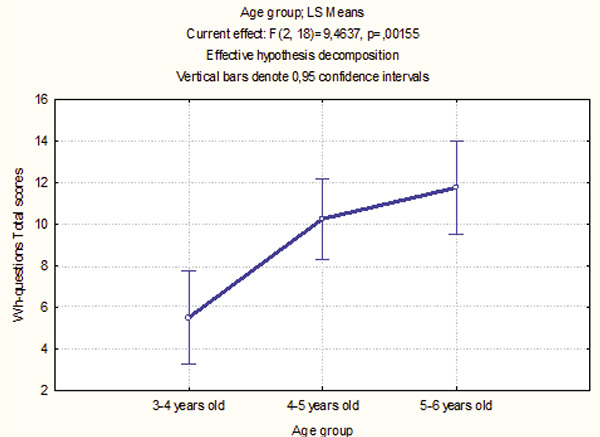
Figure 1. Wh- questions - total score as a function of Age group.
The figure shows that the children successfully performed this test. As the children grew older, their knowledge grew. The differences between the age groups are statistically significant (p > 0.001).
Figure 2 shows the differences between children of different genders and ages performing the same test.
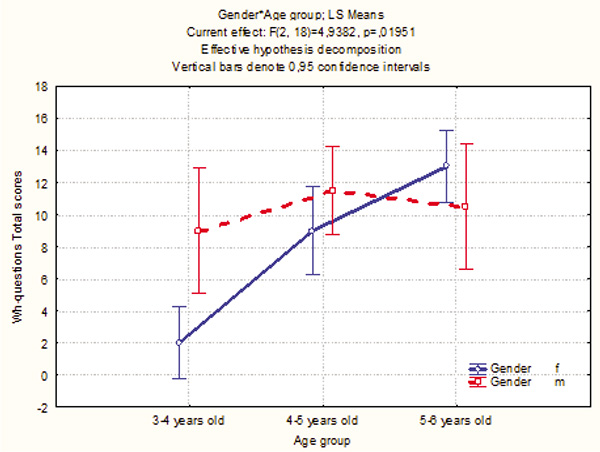
Figure 2. Influence of interaction between factors Gender and Age group on Wh- questions. Total score as a dependent variable.
The Figure 2 shows that the boys performed much better on the test than the girls did. The differences between the two groups are statistically significant (p > 0.01)
Figure 3 shows the influence of age on the children’s performance on Test 2, wh- complements. This test included questions such as: “The mother said/told her son to get her a big pot, but he got her a big glass instead. What did the mother say/tell her son to get?” The results from this test are shown below.
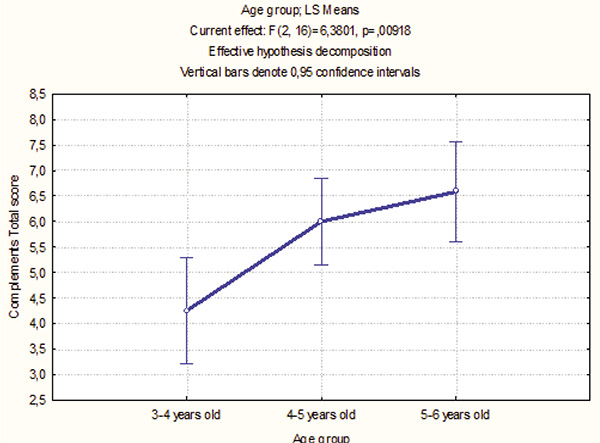
Figure 3. Wh- complements - total score as a function of Age group.
As one can see from the figure, the groups showed progress with the growth of age. The differences between the groups were statistically significant (p > 0.001). So, by the age of 5-6 years, the children answered these types of questions more correctly than did the 3-4 year-olds.
Let us see if there were differences in the performance of this subtest between the boys and the girls. The results are shown in Figure 4.
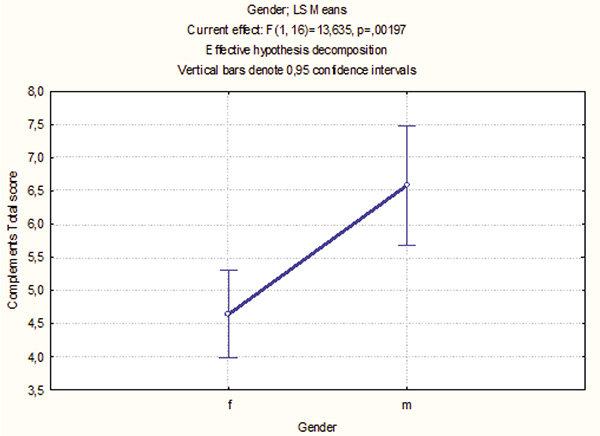
Figure 4. Wh- complements - total score as a function of Gender.
Again, the boys did much better than the girls in performing the second subtest. The differences between the boys and the girls were statistically significant (p > 0.001).
Subtest 3 dealt with the children’s knowledge of passive verbs. The children were shown pictures with multiple choice options and were given sentences such as: The horse was kicked by the dog. The results are shown in the next figures. Figure 5 shows the influence of age.
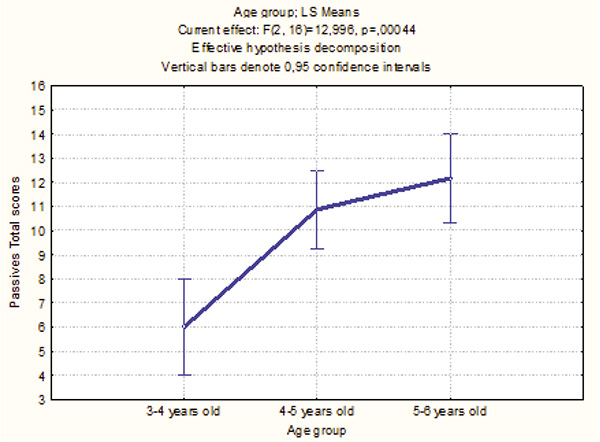
Figure 1. Passive verbs - total score as a function of Age group
Here also the increase in age went along with increases in the children’s knowledge of this grammatical category, passive verbs. Again, the older children had better results than the younger children. The differences between the groups were statistically significant (p > 0.000)
What is the influence of gender? The results are shown in Figure 6.
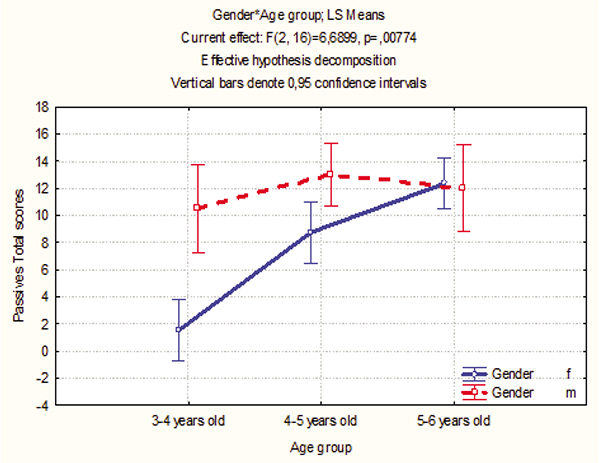
Figure 6. Influence of interaction between factors Gender and Age group on the Passives test. Total score as a dependent variable
In the performance of this test, again the boys did better, and the statistical differences between the girls and boys were significant. The boys better understood the passive voice, but by the age of 5-6 years, the knowledge of the boys and girls was equalized.
In the next sub-test – repetition of sentences – the children had the task of repeating simple and complex sentences in Romani. The results are shown in the Figure 7 and Figure 8.
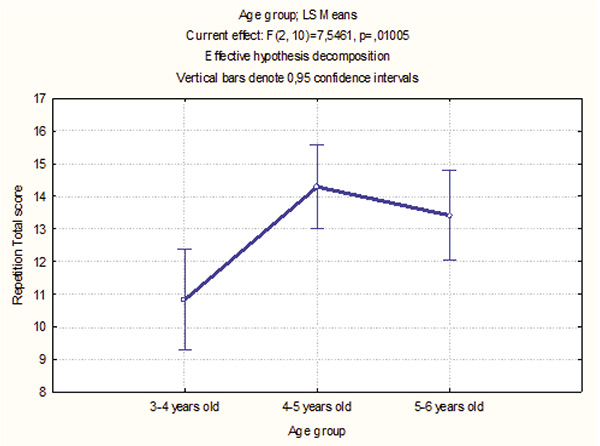
Figure 7. Repetition - total score as a function of Age group
Figure 7 shows that the differences between the groups are statistically significant, and the older children were repeating the sentences much better than the younger ones (p > 0.01)
Again, in the performance of this test the boys did much better than the girls. The results are shown in Figure 8.
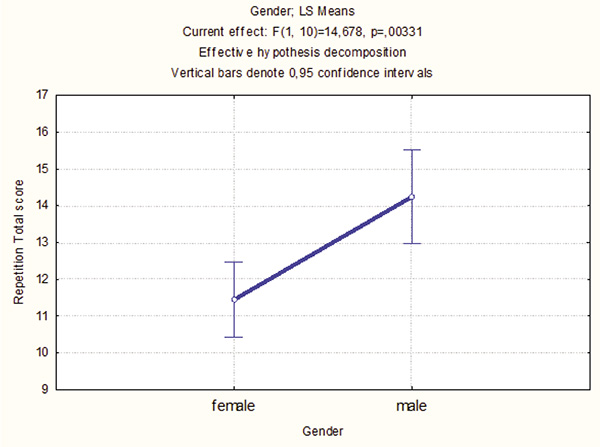
Figure 8. Repetition - total score as a function of Gender
The differences between the boys and girls are statistically significant. The boys could repeat the sentences much more accurately. A big proportion of the sentences were complex, so in order to be able to repeat them, the child had to have understood these structures and used them in his communication.
In the next test – Possessives – the children had the task of applying old knowledge to new objects and subjects. For example, to produce a sentence about the horse’s balloon while looking at a picture is easy for the children, but what happens if we have an unknown subject and object, for example, Boko as a subject and suki as an object. Boko and suki are made-up words, which do not exist in the Romani language. Do the children know to use the grammatical rules about possessives and apply them to words that are new to them? The results show that the children could do that successfully, and there were no statistical differences between the age groups. All the age groups performed this test equally well, but when comparing the result of the boys and girls, we saw again that the boys did better than the girls. The differences are statistically significant (p > 0.0000) This is shown in Figure 9.
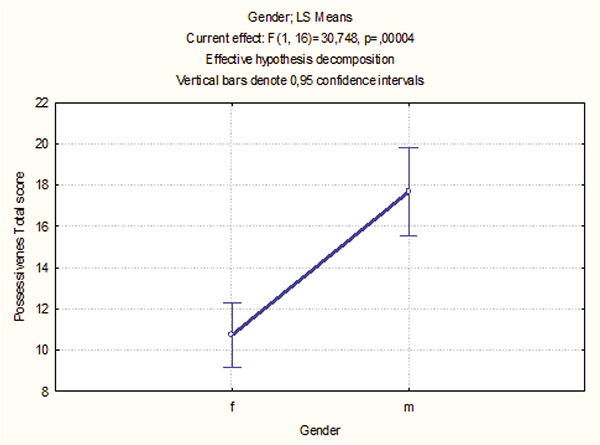
Figure 9. Possessives - total score as a function of Gender
The Tense test showed that the children knew and used correctly the Present, Future, and Past tenses. Here also, as in the previous test, there were made-up verbs which do not exist in Romani, and the children were tested as to whether they could apply the grammatical rules for the three tenses to verbs unknown to them. The results show that the children were performing the test successfully, and that there are statistically significant differences between the groups (p > 0.01). This is shown in Figure 10.
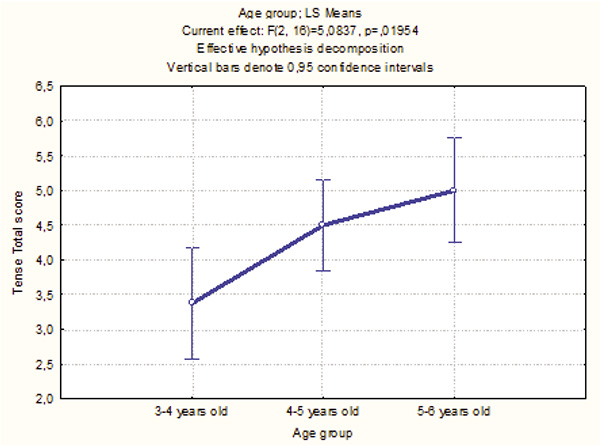
Figure 10. Tense - Total score as a function of Age group
Again, the boys were much better at performing this test. The differences between the results of the boys and the girls are statistically significant (p > 0.0000). This shown in Figure 11.
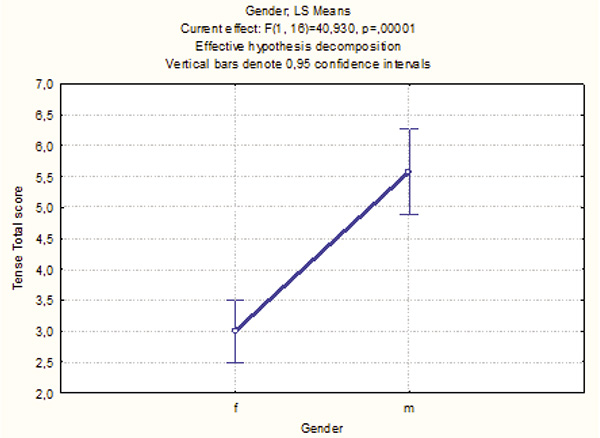
Figure 11. Tense - total score as a function of Gender
The Aspect tests measured the children’s knowledge of the aspect of the verbs. In Romani, as in many Slavic languages, there are two aspects: complete and incomplete. One and the same verb can show both actions, depending on the suffixes used. However, the children were given made-up verbs and this tested their ability to apply the grammatical rules using different suffixes to unknown verbs. The results are given in Figure 12.
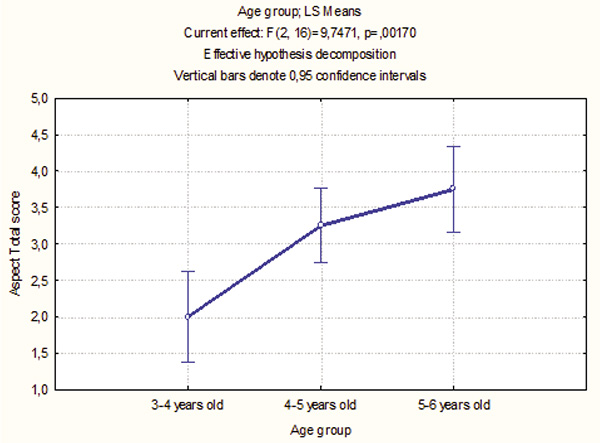
Figure 12. Aspect - total score as a function of Age group
The results of the groups are statistically significant (p > 0.001). Older children were much better at applying the suffixes to unknown verbs than the younger children. However, all of them could follow the rules and use them correctly. Who did better, the boys or the girls? This is shown in Figure 13.
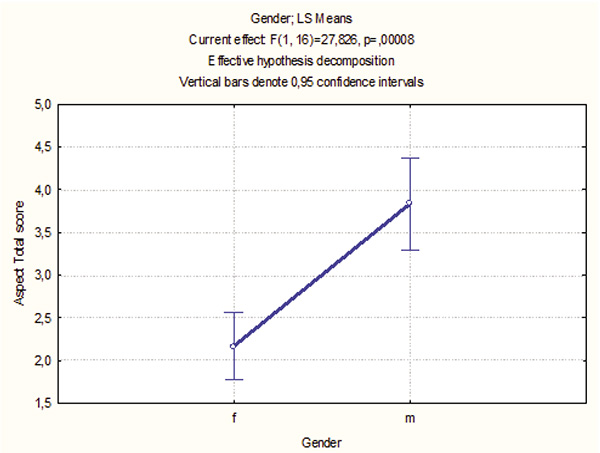
Figure 13. Aspect - total score as a function of Gender
Again, the boys performed better on this test. It seems they knew the rules of this grammatical category better than the girls did.
In most studies on children’s language development around the world, the girls are the ones who have better language skills than boys. But as we see in this study, the boys are actually performing better than the girls on all the tests. This means that the boys have better developed grammar. But why is that? Why did the boys have better language skills in Romani than the girls?
In general in this particular community, the language used for communication is an ethnolect of Croatian. The Roma developed among themselves a variant of Croatian which is different from both standard Croatian and the dialects spoken by Croats. Any native speaker of Croatian can tell that the Croatian spoken by the Roma has an accent which makes it very different from the Croatian spoken by Croats.
Roma girls, who are usually kept at home to help their mothers in taking care of the younger boys and all the household activities, usually hear their mothers speak to them in an ethnolect of Croatian. The boys, who are more actively involved with their fathers in activities outside their community, hear their fathers communicating with them in Romani, because outside the community, Romani serves as a secret language. So due to the fact that the boys are more often with their fathers, who speak Romani to them, they learn Romani better than the girls, who stay at home and hear their mothers speaking to them in a variant of Croatian.
In the Croatian language
Out of seven sub-tests, three were also performed in Croatian. Here are the results.
The first test was on the wh-questions. The results are shown in Figure 14.
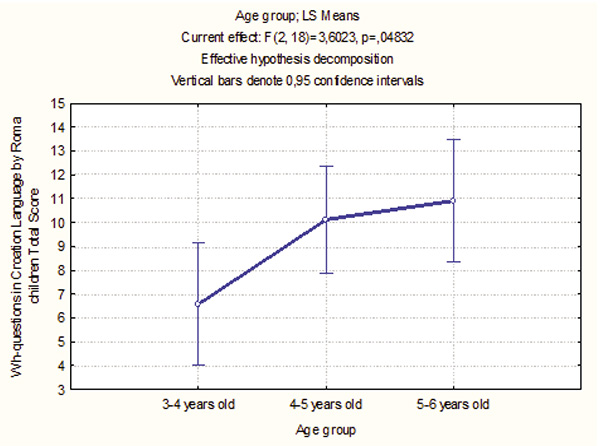
Figure 14. Wh-questions in Croatian Language as a function of age group
As in the results of performing this test in Romani, we see that the children’s knowledge increased as they got older. Older children did better than the younger children. There are no statistical differences between the performance of the test by girls or boys.
The second test was also successfully performed in the Croatian language.
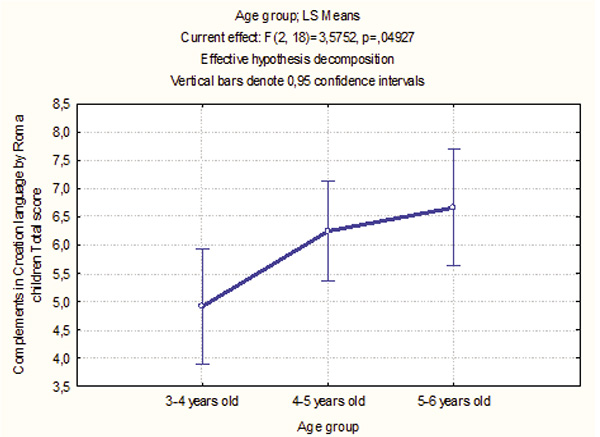
Figure 15. Complements in Croatian as a function of age group
The children also understood this test very well and answered all questions correctly. The differences between the groups are statistically significant, and the best were the older children.
The third test (passives) was a bit difficult for the children because in everyday Croatian, the passive voice is not used very much. But still it seems as though the children can perform the test; the results are shown in Figure 16.
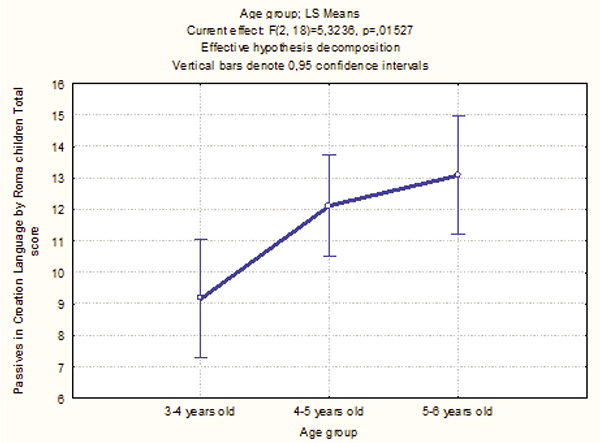
Figure 16. Passives as a function of age group
As can be seen from the figure, the children also performed well on this test. The differences between the groups are significant, and the older children had better knowledge about passive verbs than the younger ones.
Theory of Mind Tasks
The children were given two Theory of Mind tasks. They are called False-Belief Tasks, and the main idea is to check whether the children are able to “read” other people’s mental states. The first task was called “unexpected contents” – where the child is shown an empty box of chocolates and is asked what he thinks is in the box. When the box is opened, the child finds that there are no chocolates in there, but only a pencil. Then the child is asked two questions: what did he think was in the box when he saw it for the first time? And what would a doggy puppet think if we showed the box to him?
The second task was called “mis displacement.” Two friends put a ball in a red box; then the one who put it there goes out and the second friend decides to change the position of the ball and puts it in the blue box. The first friend comes back and looks for the ball. The questions is: In which box is he going to look for the ball?
The results are presented in the following figures.
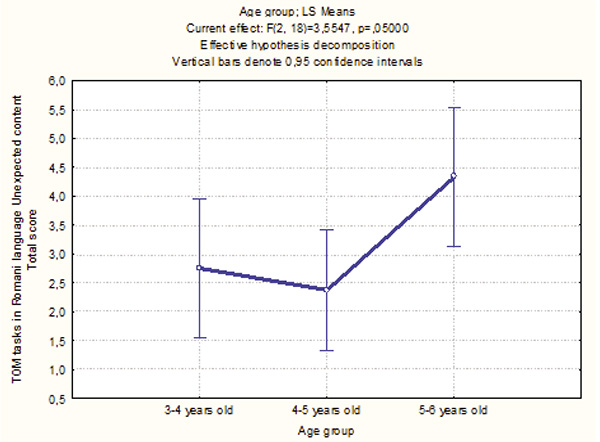
Figure 17. Unexpected content in Romani as a Function of age group
The figure shows that the younger children were not good at performing the test, but older children could perform it better. The differences between the groups are statistically significant. There are no statistical differences between the group of the boys and the girls.
In the performance of the second False-Belief task, however, there are such differences. This is shown in Figure 18.
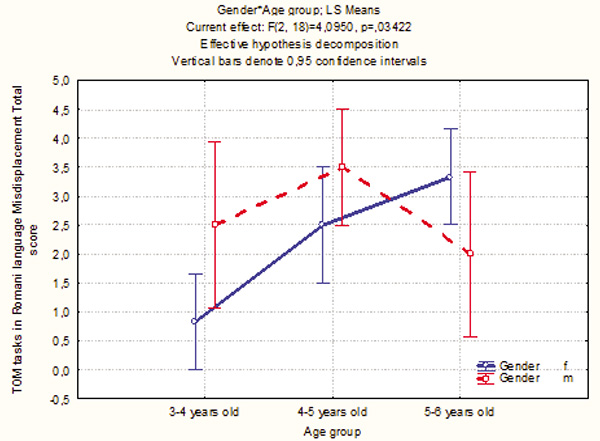
Figure 18. Mis displacement Task in Romani as a function of Gender
One can see that the boys were better at performing this task. The differences are statistically significant between the two groups. Although the oldest group showed some decrement in the results, still as a group the boys were much better than the girls.
These were the results in Romani. How did the children perform the same tasks in Croatian? Figure 19 contains the results from the first task.
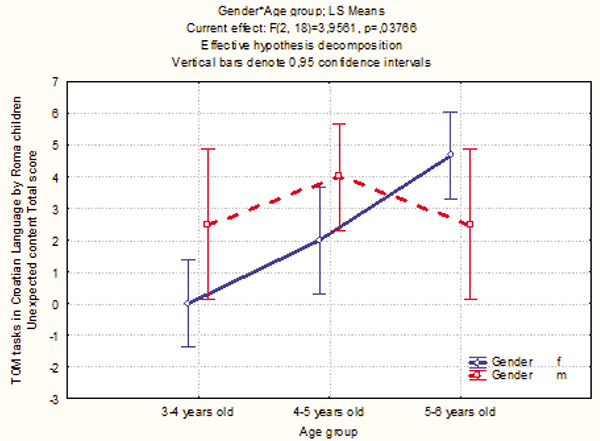
Figure 19. Unexpected content in Croatian as a function of Gender
In performing this task, the boys again achieved better results and in general, all the children understood the task. But as can be seen, the 3-4 year old girls fell far behind the 3-4 year-old boys. Although the girls spoke more Croatian, it seems that they were still less advanced in understanding the social life around them.
Let us see what the children’s results are from the second task. They are shown in Figure 20.
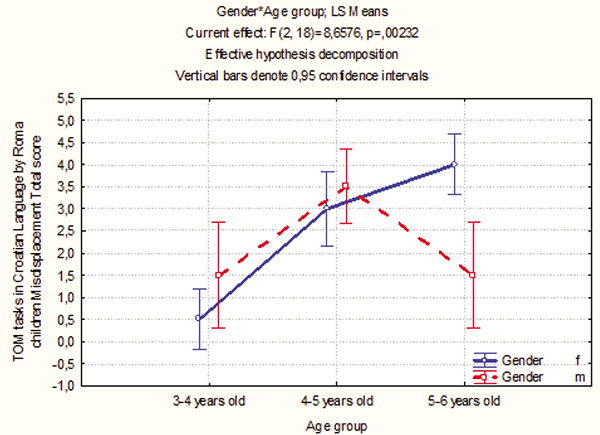
Figure 20. Mis displacement in Croatian as a function of Gender
The results show that the boys again began much better than the girls, but by the age of 5-6, the girls showed better results than the boys. The differences are statistically significant, and it seems that the fact that the girls knew Croatian helped them to get the higher results.
The results from the study show that the boys, who knew better Romani and had developed high grammatical structures in their mother tongue, were aided in developing high cognitive abilities and understanding of the social life and mental states of the people around them. The girls, who are opposite to the boys and who do not speak good Romani and speak only an ethnolect of Croatian, could not understand the social life around them and predict the mental states of other people. It turns out that the girls were not good in Romani as their mother tongue, and they were not good in Croatian, either.
Roma Parents
I conducted interviews on the children’s language use and knowledge with the parents of the children from the kindergarten in Kozari put in Zagreb. The interview had 15 questions. It was an adapted version of an interview developed at the University of Delaware, USA. Here is what I learned from the parents’ answers.
Sixty-seven percent of the parents identified as Roma and 33% as Albanians, because they spoke Albanian. Usually, Roma families are extended and there is not just one caregiver. Care for the children is a responsibility of the whole family/whole community. Very often the children are left in the house for a whole day with elder siblings in the house or some adult relatives. In this way they have access to different registers and styles of communication.
Eighty percent of the mothers were illiterate, and 20% had a primary school education. The fathers were the ones with higher education – that is, a basic school education. But the parents did not have books, including children’s books, at home and they did not read books to the children. Knowledge about the world was conveyed orally by the parents and/or elder members of the family.
Thirty-three percent of the families did not have a TV at home and the children could not have access to TV programs. In the families who had TV at home, the children watched programs for a maximum of 30 min. per day, because the parents involved the children in different family activities, and watching TV was considered to be a waste of time.
None of the families had a computer at home. None of the children had smartphones or iPads or any other electronic device. There was no computer at the kindergarten either. The children had no experience with electronic devices.
The languages used at homes were primarily Croatian and Romani. Only 33% of the parents said that they used mainly Albanian at home with their children. These were Roma families who emigrated from Kosovo because of the war in ex-Yugoslavia, and they had a strong identity as Albanians, not Roma. The Croatian spoken in the homes of the Roma and in the whole community was not the standard Croatian but rather an ethnolect, created by the Roma in their communication among themselves.
Among siblings and in communication with other children from the community, a mixture of Croatian and Romani was used. The use of Romani was more common with fathers and other male adults in the community. The mothers usually spoke more Croatian.
This small questionnaire actually provided a lot of information about the language situation of the children and their families. So, if I had to summarize the situation in this particular community, the trends are clear: most of the parents are illiterate or with low education, but use Romani in communication with their children; the children do not have access to any children’s books at home; they do not have possibility to watch TV more than 30 min. a day, and have no access to computers or other electronic devices. The languages used at home and in the community are an ethnolect of Croatian, Romani, and Albanian.
Discussion and Conclusions
The results from both the grammatical and Theory of Mind tests showed that although the Roma children grow up in poverty, they acquire the most complex grammatical categories. By the age of 5 years, they also can perform the Theory of Mind tasks. The children do not have access to new technologies such as iPads, tablets, the Internet, or TV sets. However, they grow up in a community where the communication is mainly in Romani and the children from an early age are used to different kinds of registers.
In the search for the connection between language and Theory of Mind up until now in general the scientific literature has not paid attention to complex grammatical categories but only took into account the subjects’ knowledge of different aspects of syntax. In answer to my research questions, I can say that the Roma children followed the pathway of all normally developing children learning any language as a mother tongue. Around the age of 5 years, the Roma children know most of the complex grammatical categories in their mother tongue (L1), and they have the ability to transfer their old knowledge to new objects and subjects. The children also learn the Croatian language as their second language (L2) from communication with their parents. It is clear that their knowledge of the grammatical categories is related to their understanding of ToM tasks. The boys, who know Romani grammatical categories better, are also better at solving ToM tasks in Romani, and the girls, who are better in the Croatian language, are better at solving them in the Croatian langue.
Studies done by psychologists in Europe who are trying to prove a connection between children’s ethnic Roma background and their low IQ test scores have no place in contemporary science, because we know from history what horrors these kinds of studies brought to humanity. Using old-fashioned methodologies, which are forbidden in most European countries for historical reasons, to prove the “super intelligence” of white people, does not bring any new knowledge to humanity.
Informed Consent from the Participants’ Legal Guardians
Written informed consent to participate in this study was provided by the participants’ legal guardians.
Conflict of Interest
The authors declare no conflict of interest.
References
Astington, J.W., & Jenkis, J.M. (1999). A longitudinal study of the relation between language and theory of mind development. Developmental Psychology, 35, 1311-1320. https://doi.org/10.1037/0012-1649.35.5.1311
Bakalar, P. (2004). The IQ of Gypsies in Central Europe. The Mankind Quarterly, XLIV, (3&4), 291-300. https://doi.org/10.46469/mq.2004.44.3.3
de Villiers, J.G., & de Villiers, P.A (2000). Language determinism and understanding oof false beliefs. In P. Mitchel and K. Riggs (Eds.), Children’s reasoning and the mind (pp. 191-228). Howe, East Sussex: Psychology Press.
de Villiers, J.G., & Pyers, J.E. (2002). Complements to cognition: A longitudinal study of the relationship between complex syntax and false belief understanding. Cognitive Development, 17, 1037-1060. https://doi.org/10.1016/S0885-2014(02)00073-4
Dolean, D., & Calugar, A. (2020). How reliably can we measure a child’s true IQ? Socio-Economic Status can explain most of the inter-ethnic differences in general non-verbal abilities. Frontiers in Psychology, 11. https://doi.org/10.3389/fpsyg.2020.02000
Justin, E. (1944). Lebensschicksale artfremd erzogener Zigeunerkinder und ihrer Nachkommen [The Life History of Alien-raised Gypsy Children and Their Descendants]. (Veröffentlichungen aus dem Gebiete des Volksgesundheitsdienstes. Schriftenreihe aus dem Arbeitsgebiet der Abteilung Volksgesundheit des Reichsministeriums des Innern. LVII. Band – 4. Heft). Berlin.
Kyuchukov, H., & de Villiers, J. (2018). Language Complexity, Narratives and Theory of Mind of Romani Speaking Children. East European Journal of Psycholinguistics, 5(2), 16-31. https://doi.org/10.29038/eejpl.2018.5.2.kyu
McGarry, A. (2011). The Roma voice in the European Union: Between national belonging and transnational identity. Social Movement studies, 10(3), 283-316. https://doi.org/10.1080/14742837.2011.590030
Premack, D., & Woodruff, G. (1978). Does the chimpanzee have a theory of mind? Behavioural and Brain Sciences, 4, 515-526. https://doi.org/10.1017/S0140525X00076512
Rushton, J.P., Cvorovic, J., & Bons, T.A. (2007). General mental ability in South Asians: data from there Roma (Gypsy) communities in Serbia. Intelligence, 35, 1-12. https://doi.org/10.1016/j.intell.2006.09.002
Slade, L., & Ruffman, T. (2005). How the language does and (does not) relate to theory of mind: A longitudinal study of syntax, semantics, working memory and false belief. British Journal of Developmental Psychology, 23, 117-141. https://doi.org/10.1348/026151004X21332
Smith, M., Apperly, I., & White, V. (2003). False belief reasoning and the acquisition of relative clause sentences. Child Development, 74, 709-719. https://doi.org/10.1046/j.1467-8624.2003.00633.x
Wimmer, H., & Perner, J. (1983). Beliefs about beliefs: Representation and constraining function of wrong beliefs in young children’s understanding of deception. Cognition, 13, 103-128. https://doi.org/10.1016/0010-0277(83)90004-5
Yudel, M., Roberts, D., Desalle, R., & Tishkoff, S. (2016). Taking race out of human genetics. Science, 351(6273), 564-565. https://doi.org/10.1126/science.aac4951


